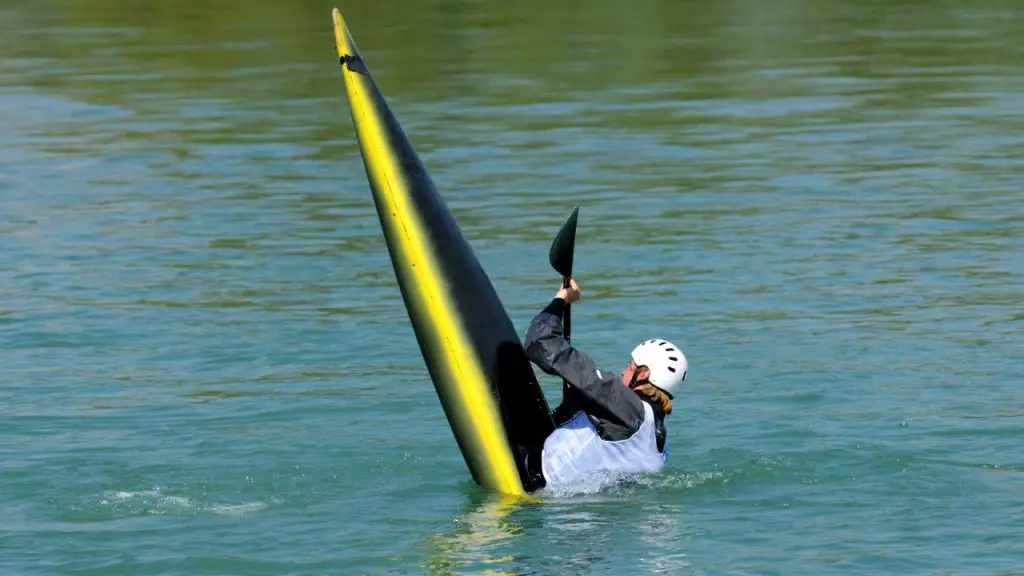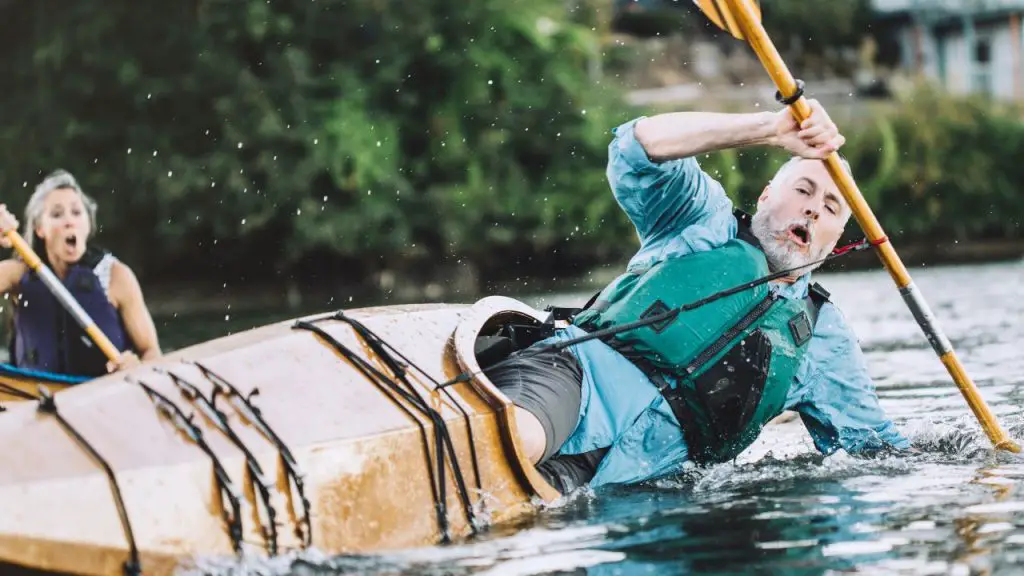While kayaks do not easily tip over, it’s still a possibility. The good news is, there are some techniques and strategies that help significantly reduce the risk. For anyone who is new to kayaking, it’s important to learn the art of keeping the vessel from tipping over.
In this post, we are going to share some tips and tricks that will make your paddling tour safer and more enjoyable. Here we will also answer some other frequently asked questions about necessary safety measures for kayaking.
Table of Contents
Do Kayaks Flip Over Easily?
No, kayaks do not flip over easily–they are remarkably stable. They perform pretty well even in relatively rough conditions. However, risks are still there, so it’s important to adopt some safety measures.
The risk of a kayak tipping over depends on factors such as the type of water, and the type of kayak you are using, and your paddling skills.

Why Did Your Kayak Flip?
If a kayak flips over, there are several possible reasons for the accident: loss of balance, big waves, excessive weight, and strong currents.
Today’s kayaks are pretty stable. Yet, if you happen to lose balance or stumble when standing in your kayak, the vessel may flip over. It can happen when using a touring kayak as a fishing platform and standing in it. The risk is relatively low if you are using a sit-on-top kayak.
If your kayak encounters a breaking wave, the vessel is likely to capsize unless you take preventative measures. A wave begins to break in when the depth of water is about 1.3 times more than the height of the wave.
If you are kayaking in open water with strong currents, your vessel may be pushed off course, and thus it may capsize. It can be a troublesome situation.
An overloaded kayak is not likely to sink or capsize immediately. But it will sit lower in the water and be at a higher risk of capsizing.
Sit-in/Sit-on-Top Kayak: Which May Flip Easier?
The stability of a kayak basically depends on the vessel’s hull. Kayaks these days are very stable, and the hulls are designed in many different ways.
It is not easy to state whether a sit-in kayak or sit-on-top kayak is easier to flip, because each type of kayak is designed in several different ways. To some extent the likelihood of capsizing depends on the type of material used to build the kayak.
But one thing is for sure. Once your kayak has flipped over, getting out of the vessel is easier if it is a sit-on-top kayak. You may have a feeling of confinement when you are in a sit-in kayak. And you may not immediately get out of the seat when the vessel capsizes. It may require a conscious effort to get out of the seat.

How To Stop Your Kayak from Tipping Over
There are some techniques and strategies that can significantly reduce the likelihood of flipping. They include choosing the right kayak, mastering the art of balancing your kayak, and using the right brace. Let’s dive a little bit deeper:
Pick the Right Kayak
If you are planning to go kayaking on flat water, a recreational kayak is the best option for you. Choose a model that offers good primary stability. And if you are thinking of venturing into coastal environments, opt for a sea kayak that offers great secondary stability.
If the kayak happens to flip over, the way you deal with the accident largely depends on what type of kayak it is. A sit-on-top kayak is safer than a sit-in kayak, especially for a beginner.
Choose Paddling Conditions That Suit Your Ability
Plan your trips when the weather is fine. Inclement weather can make your kayaking trip bothersome, even risky. Never pick an ultra-light kayak for whitewater paddling. Your kayak may fail to withstand rapid water, and consequently capsize.
Keep Balance of Your Kayak
When sitting in your kayak, keep your upper body upright and straight. As you paddle, keep your lower back relaxed and use your core muscles. Do not jerk.
For added stability, use a set of outriggers. They significantly reduce the risk of tipping, and are often used with fishing kayaks.
Use commonsense when loading gear in your kayak. The safety of the vessel largely depends on how much gear you put into it.
Place items evenly from length to length and width to width. If you tend to lose balance, slap the water with your paddle blade. This will help you stay balanced for a moment and gain momentum again.
Practice Your Paddle Skill If Your Kayak Tilts
Using a brace is a smart way to stay upright and prevent your kayak from tipping over. In fact, you are not a skilled paddler until you master the low and high brace techniques.
First, let’s see how to perform the low brace. As you start, hold the paddle shaft low in front of your chest. Rotate your wrists in the upward direction, holding the paddle blade’s back face parallel to the water. Push your elbows forward while keeping your wrists below.
When you are in this position, edge the kayak toward the side you are bracing. Keep your elbow in the upward direction and slap the water with the blade. Lean your head onto the bracing side and raise your knee simultaneously until your kayak is upright.
High brace is another effective technique to prevent your kayak from capsizing. To get started, hold the paddle shaft higher than you would when performing the low brace.
Hold your paddle blade’s power face parallel to the water, with your wrists rotating backward and your elbows pointing downward. Keep your elbows in the same position while edging the kayak onto the bracing side.
Now slap the water with the blade and simultaneously tilt your head toward the bracing side. Keep your upper body in the same position and your head tilted while raising your knee until your kayak is upright.
Practice Flipping and Re-Entering Your Kayak
Prepare yourself for the event of a capsize. Rather than waiting for an emergency, flip your kayak intentionally and see how hard or easy it is to re-enter the vessel. In this way, you will sharpen your skills, gain confidence, and be better prepared to deal with things if your kayak actually capsizes.
Could It Be Fatal If I Capsize a Kayak?
Yes, it could be. Capsizing a kayak can be dangerous, just as accidents while crossing a street, riding a bike, or driving to work. Adopt some preventative measures to minimize the risk of a capsize, and stay prepared for the worst.
Whenever you are in a kayak, wear a personal flotation device or life vest. And if you think you are unprepared to handle a water vessel, consider discarding the idea of kayaking altogether. There are many other interesting ways to spend your time, and you will find one that fits your temperament.
ONYX M-16 Belt Pack Manual Inflatable Life Jacket
What To Do If Your Kayak Capsizes?
In the event of a capsize, the most important thing is to stay calm. Once you realize that your kayak has capsized, focus on your safety.
Get the flipped kayak upright and then get back to the seat. Lighten the kayak by getting water out of it. The way you deal with the situation depends on the type of the kayak and the number of people using the kayak.
Focus on saving yourself if you are alone. And if you are in a group, do what you need to do to ensure the safety of you and your buddies.
Self-Rescue
If you are prepared, dealing with an accidental capsize is not that scary. In general, getting back into a sit-on-top kayak is easier. This is because there is no spray skirt, and the design of the boat makes it easier for you to get your legs in place.
With a sit-on-top kayak, you just have to remove scupper plugs and use a simple sponge to soak up water. And therefore the process of re-entering is a lot easier.
If your kayak is upside down, flip it upright first. Position yourself alongside the vessel, in front of your seat. Hold the edge of the boat firmly while allowing your lower body to float on the water. Then haul yourself up onto the vessel and get back to your seat.
Rescuing yourself and getting back into the kayak can be a bit more complicated if it is a sit-in kayak. If you notice that your kayak has capsized and you are still in the seat, make a conscious effort to get out of the seat.
Flip the vessel upright and tightly hold the cockpit rim. Then haul yourself up onto the deck, get into the seat and slide both of your legs inside. Use a bilge pump—if you have one in your kayak—to remove water from the vessel. If you are close to the shore, take the kayak ashore and get water out of it.
Get Help
Mastering a technique known as T-rescue can be immensely rewarding for a paddler. It refers to getting the help of a buddy when your kayak flips. Of course, T-rescue works only if there is a buddy nearby. Here’s what the procedure looks like:
With a rescuer nearby, your kayak flips. To let the rescuer know that you need help, you slap both sides of the boat with your hands several times. The rescuer kayak approaches your kayak at 90°. You grab the boat’s bow and with this support, you get upright.
FAQs
What happens if your kayak flips over?
Don’t panic when your kayak flips. Stay calm, get the boat upright, and then get back to your seat. The ease or difficulty of the process depends on the type of kayak you have.
Is it easier to flip: kayaks or canoes?
While kayaks are more speedy and nimble, canoes offer more stability, thanks to their design. In general, a canoe is less likely to flip than a kayak.
Do all kayaks sink?
Kayaks these days are remarkably stable, and they do not easily capsize. But they are not unsinkable. The likelihood depends on the type of the kayak, the water conditions, and your paddling skills.
Conclusion
Kayaks do not flip over easily, but it’s still a possibility, and every kayaker should be prepared to deal with a capsize. The best way to prepare is to flip your kayak intentionally and practice re-entering the vessel. And once you have mastered the necessary techniques, you are ready to go.
Kayaking is an art, and you gain better at it as you gain experience. If you have an enthusiastic and lighthearted approach to your kayaking tour, you will enjoy every moment of the tour, even when your kayak tips over!

